

Compact Muon Solenoid
LHC, CERN
| CMS-PAS-SUS-23-002 | ||
| Search for supersymmetric particle pair production in final states with two oppositely charged leptons and large missing transverse momentum in proton-proton collisions at $ \sqrt{s}= $ 13 TeV. | ||
| CMS Collaboration | ||
| 25 July 2024 | ||
| Abstract: A search for pair production of supersymmetric particles in events with two oppositely charged leptons (electrons or muons) and missing transverse momentum is reported. The data sample corresponds to an integrated luminosity of 138 fb$^{-1}$ of proton-proton collisions at $ \sqrt{s}= $ 13 TeV collected with the CMS detector at the LHC. No significant deviation is observed from the predicted standard model background. The results are interpreted in terms of several simplified models for chargino or slepton pair production, assuming $ R $-parity conservation and with the neutralino as the lightest supersymmetric particle. For the chargino production, an exclusion region in the ($ m_{\tilde{\chi}_1^{\pm}}, m_{\tilde{\chi}_1^0} $) plane is determined, extending to chargino masses of 1100 GeV and neutralino masses of 480 GeV, while slepton masses are excluded up to 700 GeV and neutralino masses up to 360 GeV. | ||
| Links: CDS record (PDF) ; CADI line (restricted) ; | ||
| Figures | |

png pdf |
Figure 1:
Simplified-model diagrams of chargino pair production with two benchmark decay modes: the left plot shows decays through intermediate sleptons or sneutrinos, while the right one displays prompt decays into a W boson and the lightest neutralino. |

png pdf |
Figure 1-a:
Simplified-model diagrams of chargino pair production with two benchmark decay modes: the left plot shows decays through intermediate sleptons or sneutrinos, while the right one displays prompt decays into a W boson and the lightest neutralino. |
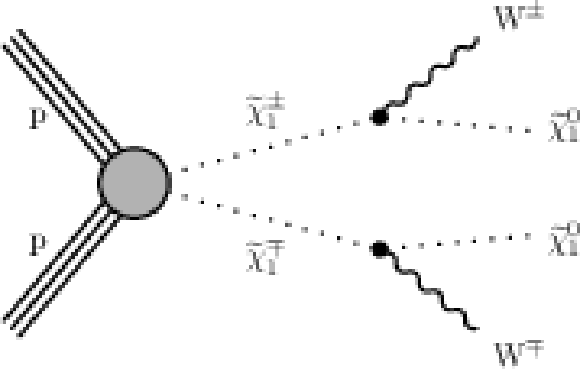
png pdf |
Figure 1-b:
Simplified-model diagrams of chargino pair production with two benchmark decay modes: the left plot shows decays through intermediate sleptons or sneutrinos, while the right one displays prompt decays into a W boson and the lightest neutralino. |

png pdf |
Figure 2:
Simplified-model diagram of charged slepton pair production. We focus on a scenario where each slepton decays into a charged lepton and a neutralino. |

png pdf |
Figure 3:
Distributions of $ m_{\mathrm{T2}}(\ell\ell) $ after the fit to data for DF events in the chargino/slepton SRs. The first two rows are for events without b-tagged jets and with 160 $ \le p_{\mathrm{T}}^\text{miss} < $ 220 GeV and 220 $ \le p_{\mathrm{T}}^\text{miss} < $ 280 GeV, respectively, further divided in events with no jets (left plots) or with at least one jet (right plots). The last row is for events without b-tagged jets and with 280 $ \le p_{\mathrm{T}}^\text{miss} < $ 380 GeV (left plot) and $ p_{\mathrm{T}}^\text{miss}\ge $ 380 GeV (right plot). The grey histogram shows the expected $ m_{\mathrm{T2}}(\ell\ell) $ distribution for chargino pair production with $ m_{\tilde{\chi}_{1}^{\pm}}= $ 800 GeV and $ m_{\tilde{\chi}_{1}^{0}}= $ 200 GeV. The expected total SM contributions before the fit (cyan dashed line) is also shown. The last bin includes the overflow entries. In the bottom panel, the ratio of data and SM expectations is shown for the expected total SM contribution after the fit using the background-only hypothesis (black dots) and before any fit (cyn dashed line). The hatched band represents the total uncertainty after the fit. |

png |
Figure 3-a:
Distributions of $ m_{\mathrm{T2}}(\ell\ell) $ after the fit to data for DF events in the chargino/slepton SRs. The first two rows are for events without b-tagged jets and with 160 $ \le p_{\mathrm{T}}^\text{miss} < $ 220 GeV and 220 $ \le p_{\mathrm{T}}^\text{miss} < $ 280 GeV, respectively, further divided in events with no jets (left plots) or with at least one jet (right plots). The last row is for events without b-tagged jets and with 280 $ \le p_{\mathrm{T}}^\text{miss} < $ 380 GeV (left plot) and $ p_{\mathrm{T}}^\text{miss}\ge $ 380 GeV (right plot). The grey histogram shows the expected $ m_{\mathrm{T2}}(\ell\ell) $ distribution for chargino pair production with $ m_{\tilde{\chi}_{1}^{\pm}}= $ 800 GeV and $ m_{\tilde{\chi}_{1}^{0}}= $ 200 GeV. The expected total SM contributions before the fit (cyan dashed line) is also shown. The last bin includes the overflow entries. In the bottom panel, the ratio of data and SM expectations is shown for the expected total SM contribution after the fit using the background-only hypothesis (black dots) and before any fit (cyn dashed line). The hatched band represents the total uncertainty after the fit. |

png |
Figure 3-b:
Distributions of $ m_{\mathrm{T2}}(\ell\ell) $ after the fit to data for DF events in the chargino/slepton SRs. The first two rows are for events without b-tagged jets and with 160 $ \le p_{\mathrm{T}}^\text{miss} < $ 220 GeV and 220 $ \le p_{\mathrm{T}}^\text{miss} < $ 280 GeV, respectively, further divided in events with no jets (left plots) or with at least one jet (right plots). The last row is for events without b-tagged jets and with 280 $ \le p_{\mathrm{T}}^\text{miss} < $ 380 GeV (left plot) and $ p_{\mathrm{T}}^\text{miss}\ge $ 380 GeV (right plot). The grey histogram shows the expected $ m_{\mathrm{T2}}(\ell\ell) $ distribution for chargino pair production with $ m_{\tilde{\chi}_{1}^{\pm}}= $ 800 GeV and $ m_{\tilde{\chi}_{1}^{0}}= $ 200 GeV. The expected total SM contributions before the fit (cyan dashed line) is also shown. The last bin includes the overflow entries. In the bottom panel, the ratio of data and SM expectations is shown for the expected total SM contribution after the fit using the background-only hypothesis (black dots) and before any fit (cyn dashed line). The hatched band represents the total uncertainty after the fit. |
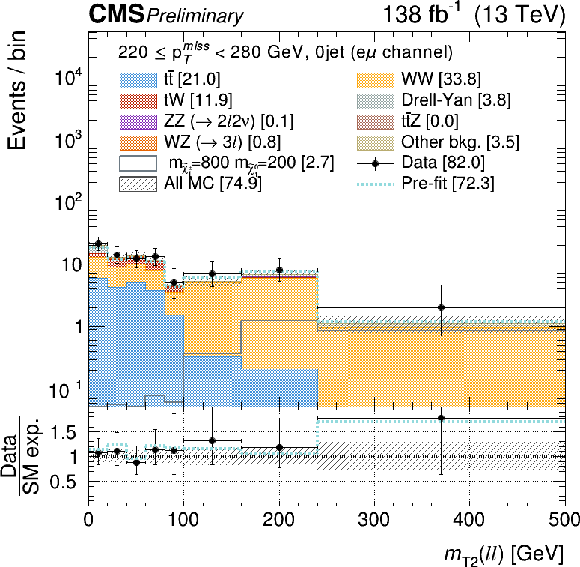
png |
Figure 3-c:
Distributions of $ m_{\mathrm{T2}}(\ell\ell) $ after the fit to data for DF events in the chargino/slepton SRs. The first two rows are for events without b-tagged jets and with 160 $ \le p_{\mathrm{T}}^\text{miss} < $ 220 GeV and 220 $ \le p_{\mathrm{T}}^\text{miss} < $ 280 GeV, respectively, further divided in events with no jets (left plots) or with at least one jet (right plots). The last row is for events without b-tagged jets and with 280 $ \le p_{\mathrm{T}}^\text{miss} < $ 380 GeV (left plot) and $ p_{\mathrm{T}}^\text{miss}\ge $ 380 GeV (right plot). The grey histogram shows the expected $ m_{\mathrm{T2}}(\ell\ell) $ distribution for chargino pair production with $ m_{\tilde{\chi}_{1}^{\pm}}= $ 800 GeV and $ m_{\tilde{\chi}_{1}^{0}}= $ 200 GeV. The expected total SM contributions before the fit (cyan dashed line) is also shown. The last bin includes the overflow entries. In the bottom panel, the ratio of data and SM expectations is shown for the expected total SM contribution after the fit using the background-only hypothesis (black dots) and before any fit (cyn dashed line). The hatched band represents the total uncertainty after the fit. |
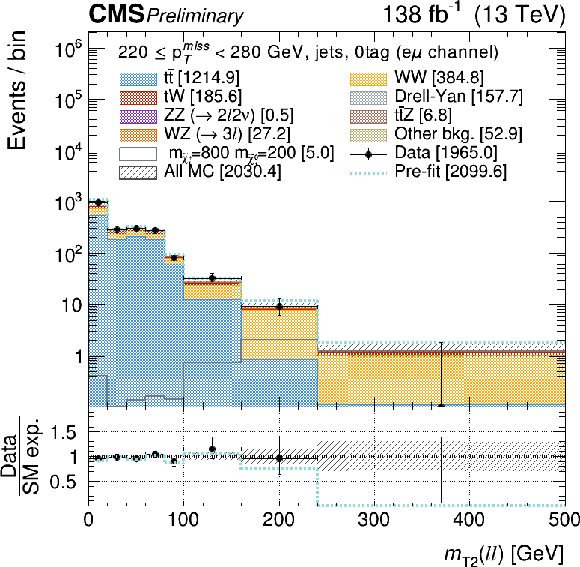
png |
Figure 3-d:
Distributions of $ m_{\mathrm{T2}}(\ell\ell) $ after the fit to data for DF events in the chargino/slepton SRs. The first two rows are for events without b-tagged jets and with 160 $ \le p_{\mathrm{T}}^\text{miss} < $ 220 GeV and 220 $ \le p_{\mathrm{T}}^\text{miss} < $ 280 GeV, respectively, further divided in events with no jets (left plots) or with at least one jet (right plots). The last row is for events without b-tagged jets and with 280 $ \le p_{\mathrm{T}}^\text{miss} < $ 380 GeV (left plot) and $ p_{\mathrm{T}}^\text{miss}\ge $ 380 GeV (right plot). The grey histogram shows the expected $ m_{\mathrm{T2}}(\ell\ell) $ distribution for chargino pair production with $ m_{\tilde{\chi}_{1}^{\pm}}= $ 800 GeV and $ m_{\tilde{\chi}_{1}^{0}}= $ 200 GeV. The expected total SM contributions before the fit (cyan dashed line) is also shown. The last bin includes the overflow entries. In the bottom panel, the ratio of data and SM expectations is shown for the expected total SM contribution after the fit using the background-only hypothesis (black dots) and before any fit (cyn dashed line). The hatched band represents the total uncertainty after the fit. |

png |
Figure 3-e:
Distributions of $ m_{\mathrm{T2}}(\ell\ell) $ after the fit to data for DF events in the chargino/slepton SRs. The first two rows are for events without b-tagged jets and with 160 $ \le p_{\mathrm{T}}^\text{miss} < $ 220 GeV and 220 $ \le p_{\mathrm{T}}^\text{miss} < $ 280 GeV, respectively, further divided in events with no jets (left plots) or with at least one jet (right plots). The last row is for events without b-tagged jets and with 280 $ \le p_{\mathrm{T}}^\text{miss} < $ 380 GeV (left plot) and $ p_{\mathrm{T}}^\text{miss}\ge $ 380 GeV (right plot). The grey histogram shows the expected $ m_{\mathrm{T2}}(\ell\ell) $ distribution for chargino pair production with $ m_{\tilde{\chi}_{1}^{\pm}}= $ 800 GeV and $ m_{\tilde{\chi}_{1}^{0}}= $ 200 GeV. The expected total SM contributions before the fit (cyan dashed line) is also shown. The last bin includes the overflow entries. In the bottom panel, the ratio of data and SM expectations is shown for the expected total SM contribution after the fit using the background-only hypothesis (black dots) and before any fit (cyn dashed line). The hatched band represents the total uncertainty after the fit. |
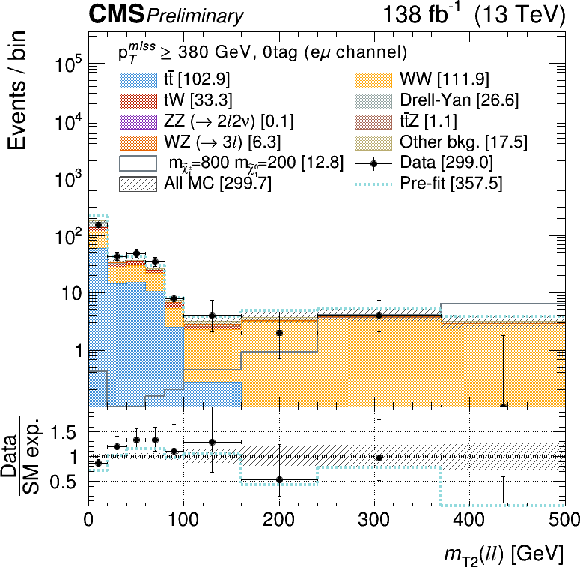
png |
Figure 3-f:
Distributions of $ m_{\mathrm{T2}}(\ell\ell) $ after the fit to data for DF events in the chargino/slepton SRs. The first two rows are for events without b-tagged jets and with 160 $ \le p_{\mathrm{T}}^\text{miss} < $ 220 GeV and 220 $ \le p_{\mathrm{T}}^\text{miss} < $ 280 GeV, respectively, further divided in events with no jets (left plots) or with at least one jet (right plots). The last row is for events without b-tagged jets and with 280 $ \le p_{\mathrm{T}}^\text{miss} < $ 380 GeV (left plot) and $ p_{\mathrm{T}}^\text{miss}\ge $ 380 GeV (right plot). The grey histogram shows the expected $ m_{\mathrm{T2}}(\ell\ell) $ distribution for chargino pair production with $ m_{\tilde{\chi}_{1}^{\pm}}= $ 800 GeV and $ m_{\tilde{\chi}_{1}^{0}}= $ 200 GeV. The expected total SM contributions before the fit (cyan dashed line) is also shown. The last bin includes the overflow entries. In the bottom panel, the ratio of data and SM expectations is shown for the expected total SM contribution after the fit using the background-only hypothesis (black dots) and before any fit (cyn dashed line). The hatched band represents the total uncertainty after the fit. |

png pdf |
Figure 4:
The same distributions of $ m_{\mathrm{T2}}(\ell\ell) $ as Fig. 3, but for SF events. |

png |
Figure 4-a:
The same distributions of $ m_{\mathrm{T2}}(\ell\ell) $ as Fig. 3, but for SF events. |
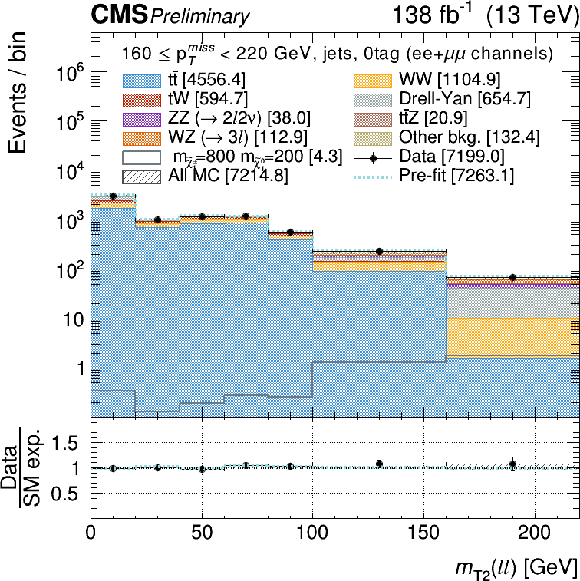
png |
Figure 4-b:
The same distributions of $ m_{\mathrm{T2}}(\ell\ell) $ as Fig. 3, but for SF events. |
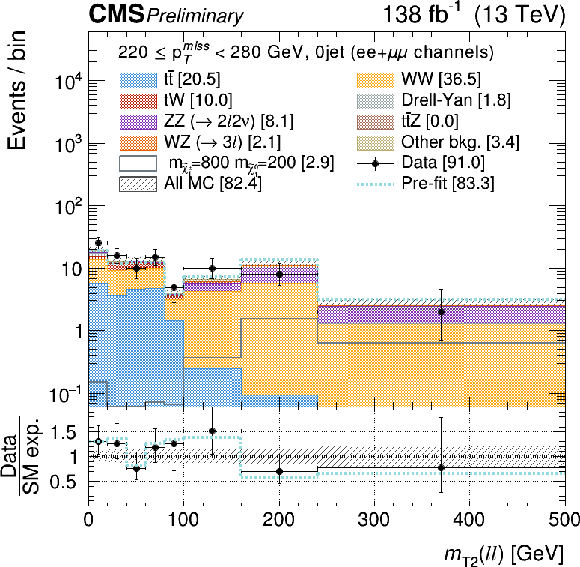
png |
Figure 4-c:
The same distributions of $ m_{\mathrm{T2}}(\ell\ell) $ as Fig. 3, but for SF events. |
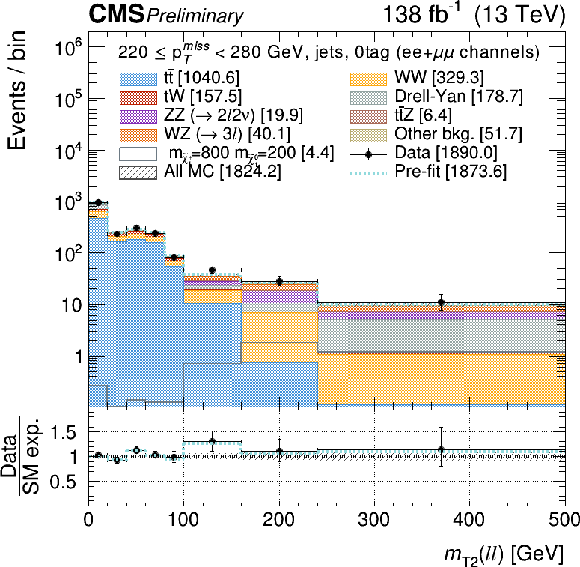
png |
Figure 4-d:
The same distributions of $ m_{\mathrm{T2}}(\ell\ell) $ as Fig. 3, but for SF events. |

png |
Figure 4-e:
The same distributions of $ m_{\mathrm{T2}}(\ell\ell) $ as Fig. 3, but for SF events. |
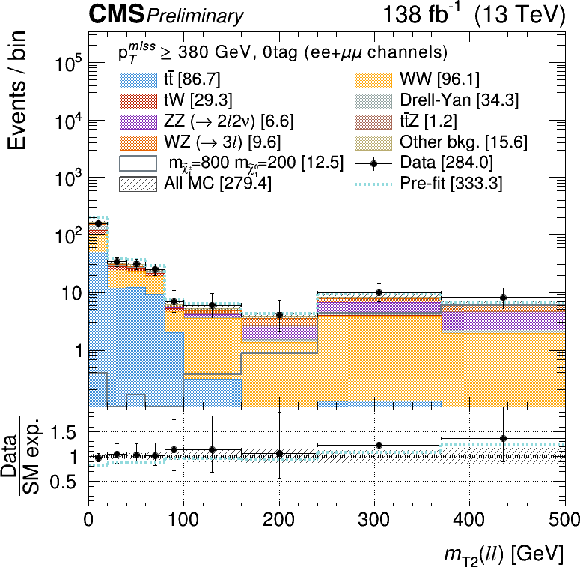
png |
Figure 4-f:
The same distributions of $ m_{\mathrm{T2}}(\ell\ell) $ as Fig. 3, but for SF events. |

png pdf |
Figure 5:
Upper limits at 95% CL on the chargino pair production cross section as a function of the chargino and neutralino masses. The plot on the left shows the results when the chargino undergoes a cascade decay $ \tilde{\chi}_{1}^{\pm}\to\widetilde{\ell}\nu (\ell\tilde{\nu}) \to\ell\nu\tilde{\chi}_{1}^{0} $. The plot on the right gives the limits assuming chargino decays into a neutralino and a W boson ($ \tilde{\chi}_{1}^{\pm}\to\mathrm{W}\tilde{\chi}_{1}^{0} $). Exclusion regions in the plane ($ m_{ \tilde{\chi}_{1}^{\pm} }$, $ m_{ \tilde{\chi}_{1}^{0} } $) are determined by comparing the upper limits with the NLO+NLL production cross sections. The thick dashed red line shows the expected exclusion region. The thin dashed (dotted) red lines show the 1 (2) $ \sigma $ variation of the expected exclusion regions due to the experimental uncertainties. The thick black line shows the observed exclusion region, while the thin black lines show the variation of the observed exclusion regions due to the theoretical uncertainties in the production cross section. |

png pdf |
Figure 5-a:
Upper limits at 95% CL on the chargino pair production cross section as a function of the chargino and neutralino masses. The plot on the left shows the results when the chargino undergoes a cascade decay $ \tilde{\chi}_{1}^{\pm}\to\widetilde{\ell}\nu (\ell\tilde{\nu}) \to\ell\nu\tilde{\chi}_{1}^{0} $. The plot on the right gives the limits assuming chargino decays into a neutralino and a W boson ($ \tilde{\chi}_{1}^{\pm}\to\mathrm{W}\tilde{\chi}_{1}^{0} $). Exclusion regions in the plane ($ m_{ \tilde{\chi}_{1}^{\pm} }$, $ m_{ \tilde{\chi}_{1}^{0} } $) are determined by comparing the upper limits with the NLO+NLL production cross sections. The thick dashed red line shows the expected exclusion region. The thin dashed (dotted) red lines show the 1 (2) $ \sigma $ variation of the expected exclusion regions due to the experimental uncertainties. The thick black line shows the observed exclusion region, while the thin black lines show the variation of the observed exclusion regions due to the theoretical uncertainties in the production cross section. |

png pdf |
Figure 5-b:
Upper limits at 95% CL on the chargino pair production cross section as a function of the chargino and neutralino masses. The plot on the left shows the results when the chargino undergoes a cascade decay $ \tilde{\chi}_{1}^{\pm}\to\widetilde{\ell}\nu (\ell\tilde{\nu}) \to\ell\nu\tilde{\chi}_{1}^{0} $. The plot on the right gives the limits assuming chargino decays into a neutralino and a W boson ($ \tilde{\chi}_{1}^{\pm}\to\mathrm{W}\tilde{\chi}_{1}^{0} $). Exclusion regions in the plane ($ m_{ \tilde{\chi}_{1}^{\pm} }$, $ m_{ \tilde{\chi}_{1}^{0} } $) are determined by comparing the upper limits with the NLO+NLL production cross sections. The thick dashed red line shows the expected exclusion region. The thin dashed (dotted) red lines show the 1 (2) $ \sigma $ variation of the expected exclusion regions due to the experimental uncertainties. The thick black line shows the observed exclusion region, while the thin black lines show the variation of the observed exclusion regions due to the theoretical uncertainties in the production cross section. |

png pdf |
Figure 6:
Upper limits at 95% CL on slepton pair production cross section as a function of the slepton and neutralino masses. Exclusion regions in the plane ($ m_{ \widetilde{\ell} } $, $ m_{\tilde{\chi}_{1}^{0} } $) are determined by comparing the upper limits with the NLO+NLL production cross sections. The thick dashed red line shows the expected exclusion region. The thin dashed (dotted) red lines show the 1 (2) $ \sigma $ variation of the expected exclusion regions due to the experimental uncertainties. The thick black line shows the observed exclusion region, while the thin black lines show the variation of the observed exclusion regions due to the theoretical uncertainties in the production cross section. |
| Tables | |

png pdf |
Table 1:
Baseline selection used in the searches for all the considered models. |

png pdf |
Table 2:
Definition of the SRs for the chargino and slepton searches as a function of the $ p_{\mathrm{T}}^\text{miss} $ value, the b-jet multiplicity and jet multiplicity, and the lepton pair channels. Also shown are the CRs with b-tagged jets used for the normalization of the $ \mathrm{t} \overline{\mathrm{t}} $ and $ \mathrm{t}\mathrm{W} $ backgrounds. The last row shows the $ m_{\mathrm{T2}}(\ell\ell) $ binning used in the ML fit performed to extract the signal. |

png pdf |
Table 3:
Sizes of systematic uncertainties in the predicted yields for SM processes. The first column shows the range of the uncertainties in the global background normalization across the different SRs. The second column quantifies the effect on the $ m_{\mathrm{T2}}(\ell\ell) $ shape. This is computed by taking the maximum variation across the $ m_{\mathrm{T2}}(\ell\ell) $ bins (after renormalizing for the global change of all the distribution) in each SR. The range of this variation across the SRs is given. |
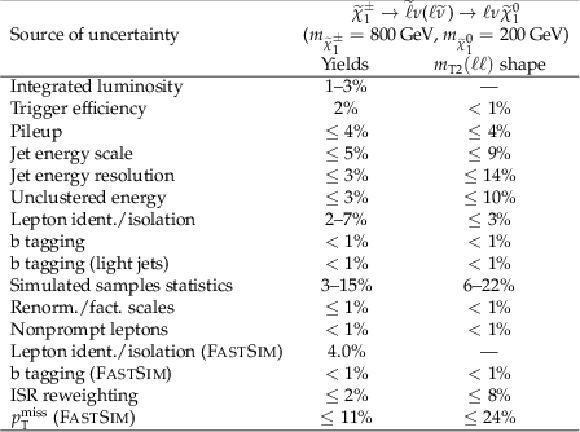
png pdf |
Table 4:
Same as in Table 3 for a representative signal mass hypothesis of chargino pair production. |

png pdf |
Table 5:
Observed and expected yields of DF (upper half) and SF (lower half) events in the SRs for the chargino/slepton search. The quoted uncertainties in the background predictions include statistical and systematic contributions. |
| Summary |
| A search has been presented for new physics in events with two oppositely charged isolated leptons and missing transverse momentum in 138 fb$^{-1}$ of proton-proton collision data collected by the CMS detector during the LHC operation at a center-of-mass energy of 13 TeV. No significant evidence for a deviation with respect to standard model predictions was observed. The results have been interpreted as upper limits on the cross sections of supersymmetric particle production for several simplified model spectra. Chargino pair production has been investigated in two possible decay modes. If the chargino is assumed to undergo a cascade decay through sleptons, an exclusion region in the ($ m_{ \tilde{\chi}_{1}^{\pm} } $, $ m_{ \tilde{\chi}_{1}^{0} } $) plane is derived, extending to chargino masses of 1100 GeV and neutralino masses of 480 GeV. Lastly, slepton pair production has been considered, excluding slepton masses up to 700 GeV and neutralino masses up to 360 GeV. |
| References | ||||
| 1 | E. Gildener and S. Weinberg | Symmetry breaking and scalar bosons | PRD 13 (1976) 3333 | |
| 2 | G. 't Hooft | Naturalness, chiral symmetry, and spontaneous chiral symmetry breaking | NATO Sci. Ser. B 59 (1980) 135 | |
| 3 | G. Bertone, D. Hooper, and J. Silk | Particle dark matter: evidence, candidates and constraints | Phys. Rept. 405 (2005) 279 | hep-ph/0404175 |
| 4 | J. L. Feng | Dark matter candidates from particle physics and methods of detection | Ann. Rev. Astron. Astrophys. 48 (2010) 495 | 1003.0904 |
| 5 | T. A. Porter, R. P. Johnson, and P. W. Graham | Dark matter searches with astroparticle data | Ann. Rev. Astron. Astrophys. 49 (2011) 155 | 1104.2836 |
| 6 | P. Ramond | Dual theory for free fermions | PRD 3 (1971) 2415 | |
| 7 | Y. A. Golfand and E. P. Likhtman | Extension of the algebra of Poincaré group generators and violation of P invariance | JETP Lett. 13 (1971) 323 | |
| 8 | A. Neveu and J. H. Schwarz | Factorizable dual model of pions | NPB 31 (1971) 86 | |
| 9 | D. V. Volkov and V. P. Akulov | Possible universal neutrino interaction | JETP Lett. 16 (1972) 438 | |
| 10 | J. Wess and B. Zumino | A Lagrangian model invariant under supergauge transformations | PLB 49 (1974) 52 | |
| 11 | J. Wess and B. Zumino | Supergauge transformations in four dimensions | NPB 70 (1974) 39 | |
| 12 | P. Fayet | Supergauge invariant extension of the Higgs mechanism and a model for the electron and its neutrino | NPB 90 (1975) 104 | |
| 13 | H. P. Nilles | Supersymmetry, supergravity and particle physics | Phys. Rep. 110 (1984) 1 | |
| 14 | S. P. Martin | A Supersymmetry primer | Advanced Series on Directions in High Energy Physics 21 (2010) 1 | hep-ph/9709356 |
| 15 | E. Witten | Dynamical breaking of supersymmetry | NPB 188 (1981) 513 | |
| 16 | S. Dimopoulos and H. Georgi | Softly broken supersymmetry and SU(5) | NPB 193 (1981) 150 | |
| 17 | Kaul, R. K. and Majumdar, P. | Cancellation of quadratically divergent mass corrections in globally supersymmetric spontaneously broken gauge theories | NPB 199 (1982) 36 | |
| 18 | G. R. Farrar and P. Fayet | Phenomenology of the production, decay, and detection of new hadronic states associated with supersymmetry | PLB 76 (1978) 575 | |
| 19 | CMS Collaboration | The CMS experiment at the CERN LHC | JINST 3 (2008) S08004 | |
| 20 | J. Alwall, P. Schuster, and N. Toro | Simplified models for a first characterization of new physics at the LHC | PRD 79 (2009) 075020 | 0810.3921 |
| 21 | J. Alwall, M.-P. Le, M. Lisanti, and J. G. Wacker | Model-independent jets plus missing energy searches | PRD 79 (2009) 015005 | 0809.3264 |
| 22 | LHC New Physics Working Group Collaboration | Simplified Models for LHC New Physics Searches | JPG 39 (2012) 105005 | 1105.2838 |
| 23 | CMS Collaboration | Searches for pair production of charginos and top squarks in final states with two oppositely charged leptons in proton-proton collisions at $ \sqrt{s}= $ 13 TeV | JHEP 11 (2018) 079 | CMS-SUS-17-010 1807.07799 |
| 24 | CMS Collaboration | Search for electroweak production of charginos and neutralinos at $ \sqrt{s}= $ 13 TeV in final states containing hadronic decays of WW, WZ, or WH and missing transverse momentum | PLB 842 (2023) 137460 | CMS-SUS-21-002 2205.09597 |
| 25 | CMS Collaboration | General search for supersymmetric particles in scenarios with compressed mass spectra using proton-proton collisions at $ \sqrt{s}= $ 13 TeV | technical report, CERN, Geneva, 2024 CDS |
|
| 26 | ATLAS Collaboration | Search for direct pair production of sleptons and charginos decaying to two leptons and neutralinos with mass splittings near the W-boson mass in $ \sqrt{s} $ = 13 TeV pp collisions with the ATLAS detector | JHEP 06 (2023) 031 | 2209.13935 |
| 27 | ATLAS Collaboration | Search for electroweak production of charginos and sleptons decaying into final states with two leptons and missing transverse momentum in $ \sqrt{s}= $ 13 TeV $ pp $ collisions using the ATLAS detector | EPJC 80 (2020) 123 | 1908.08215 |
| 28 | ATLAS Collaboration | Search for direct production of electroweakinos in final states with one lepton, jets and missing transverse momentum and in pp collisions at $ \sqrt{s} = $ 13 TeV with the ATLAS detector | link | |
| 29 | ATLAS Collaboration | Search for electroweak production of supersymmetric particles in final states with two \ensuremath\tau-leptons in $ \sqrt{s} $ = 13 TeV pp collisions with the ATLAS detector | JHEP 05 (2024) 150 | 2402.00603 |
| 30 | ATLAS Collaboration | Search for direct production of electroweakinos in final states with one lepton, jets and missing transverse momentum in pp collisions at $ \sqrt{s} $ = 13 TeV with the ATLAS detector | JHEP 12 (2023) 167 | 2310.08171 |
| 31 | ATLAS Collaboration | A statistical combination of ATLAS Run 2 searches for charginos and neutralinos at the LHC | Submitted to Physics Reports, 2024 | 2402.08347 |
| 32 | CMS Collaboration | Search for supersymmetry in final states with two oppositely charged same-flavor leptons and missing transverse momentum in proton-proton collisions at $ \sqrt{s}= $ 13 TeV | JHEP 04 (2021) 123 | CMS-SUS-20-001 2012.08600 |
| 33 | CMS Collaboration | Search for supersymmetry in final states with two or three soft leptons and missing transverse momentum in proton-proton collisions at $ \sqrt{s} $ = 13 TeV | JHEP 04 (2022) 091 | CMS-SUS-18-004 2111.06296 |
| 34 | CMS Collaboration | Combined search for electroweak production of winos, binos, higgsinos, and sleptons in proton-proton collisions at s=13 TeV | PRD 109 (2024) 112001 | CMS-SUS-21-008 2402.01888 |
| 35 | CMS Collaboration | Performance of the CMS Level-1 trigger in proton-proton collisions at $ \sqrt{s} = $ 13 TeV | JINST 15 (2020) P10017 | CMS-TRG-17-001 2006.10165 |
| 36 | CMS Collaboration | The CMS trigger system | JINST 12 (2017) P01020 | CMS-TRG-12-001 1609.02366 |
| 37 | P. Nason | A New method for combining NLO QCD with shower Monte Carlo algorithms | JHEP 11 (2004) 040 | hep-ph/0409146 |
| 38 | S. Frixione, P. Nason, and C. Oleari | Matching NLO QCD computations with Parton Shower simulations: the POWHEG method | JHEP 11 (2007) 070 | 0709.2092 |
| 39 | S. Alioli, P. Nason, C. Oleari, and E. Re | A general framework for implementing NLO calculations in shower Monte Carlo programs: the POWHEG BOX | JHEP 06 (2010) 043 | 1002.2581 |
| 40 | M. Czakon and A. Mitov | Top++: A program for the calculation of the top-pair cross-section at hadron colliders | Comput. Phys. Commun. 185 (2014) 2930 | 1112.5675 |
| 41 | E. Re | Single-top Wt-channel production matched with parton showers using the POWHEG method | EPJC 71 (2011) 1547 | 1009.2450 |
| 42 | N. Kidonakis | NNLL threshold resummation for top-pair and single-top production | Phys. Part. Nucl. 45 (2014) 714 | 1210.7813 |
| 43 | Melia, T. and Nason, P. and Rontsch, R. and Zanderighi, G. | W$ ^+ $W$ ^- $, WZ and ZZ production in the POWHEG BOX | JHEP 11 (2011) 078 | 1107.5051 |
| 44 | P. Nason and G. Zanderighi | W$ ^+ $W$ ^- $, WZ and ZZ production in the POWHEG-BOX-V2 | EPJC 74 (2014) 2702 | 1311.1365 |
| 45 | T. Gehrmann et al. | W$ ^{+} $W$ ^{-} $ production at hadron colliders in NNLO QCD | PRL 113 (2014) 212001 | 1408.5243 |
| 46 | CMS Collaboration | Measurements of properties of the Higgs boson decaying into the four-lepton final state in pp collisions at $ \sqrt{s}= $ 13 TeV | JHEP 11 (2017) 047 | CMS-HIG-16-041 1706.09936 |
| 47 | J. M. Campbell and R. K. Ellis | MCFM for the Tevatron and the LHC | Nucl. Phys. Proc. Suppl. 205 (2010) 10 | 1007.3492 |
| 48 | F. Caola, K. Melnikov, R. Rtsch, and L. Tancredi | QCD corrections to W$ ^+ $W$ ^{-} $ production through gluon fusion | PLB 754 (2016) 275 | 1511.08617 |
| 49 | P. Artoisenet, R. Frederix, O. Mattelaer, and R. Rietkerk | Automatic spin-entangled decays of heavy resonances in Monte Carlo simulations | JHEP 03 (2013) 015 | 1212.3460 |
| 50 | R. Gavin, Y. Li, F. Petriello, and S. Quackenbush | FEWZ 2.0: A code for hadronic Z production at next-to-next-to-leading order | Comput. Phys. Commun. 182 (2011) 2388 | 1011.3540 |
| 51 | M. V. Garzelli, A. Kardos, C. G. Papadopoulos, and Z. Trocsanyi | $ {\mathrm{t}\overline{\mathrm{t}}} $W$ ^{\pm} $ and $ {\mathrm{t}\overline{\mathrm{t}}} $Z hadroproduction at NLO accuracy in QCD with parton shower and hadronization effects | JHEP 11 (2012) 056 | 1208.2665 |
| 52 | LHC Higgs Cross Section Working Group | Handbook of LHC Higgs cross sections: 3. Higgs Properties | CERN, 2013 link |
1307.1347 |
| 53 | W. Beenakker et al. | Production of charginos, neutralinos, and sleptons at hadron colliders | PRL 83 (1999) 3780 | hep-ph/9906298 |
| 54 | B. Fuks, M. Klasen, D. R. Lamprea, and M. Rothering | Gaugino production in proton-proton collisions at a center-of-mass energy of 8 TeV | JHEP 10 (2012) 081 | 1207.2159 |
| 55 | B. Fuks, M. Klasen, D. R. Lamprea, and M. Rothering | Precision predictions for electroweak superpartner production at hadron colliders with Resummino | EPJC 73 (2013) 2480 | 1304.0790 |
| 56 | B. Fuks, M. Klasen, D. R. Lamprea, and M. Rothering | Revisiting slepton pair production at the Large Hadron Collider | JHEP 01 (2014) 168 | 1310.2621 |
| 57 | W. Beenakker, R. Hopker, M. Spira, and P. M. Zerwas | Squark and gluino production at hadron colliders | NPB 492 (1997) 51 | hep-ph/9610490 |
| 58 | A. Kulesza and L. Motyka | Threshold resummation for squark-antisquark and gluino-pair production at the LHC | PRL 102 (2009) 111802 | 0807.2405 |
| 59 | A. Kulesza and L. Motyka | Soft gluon resummation for the production of gluino-gluino and squark-antisquark pairs at the LHC | PRD 80 (2009) 095004 | 0905.4749 |
| 60 | W. Beenakker et al. | Soft-gluon resummation for squark and gluino hadroproduction | JHEP 12 (2009) 041 | 0909.4418 |
| 61 | W. Beenakker et al. | Squark and Gluino Hadroproduction | Int. J. Mod. Phys. A 26 (2011) 2637 | 1105.1110 |
| 62 | C. Borschensky et al. | Squark and gluino production cross sections in pp collisions at $ \sqrt{s} $ = 13, 14, 33 and 100 TeV | EPJC 74 (2014) 3174 | 1407.5066 |
| 63 | W. Beenakker et al. | NNLL resummation for squark-antisquark pair production at the LHC | JHEP 01 (2012) 076 | 1110.2446 |
| 64 | W. Beenakker et al. | Towards NNLL resummation: hard matching coefficients for squark and gluino hadroproduction | JHEP 10 (2013) 120 | 1304.6354 |
| 65 | W. Beenakker et al. | NNLL resummation for squark and gluino production at the LHC | JHEP 12 (2014) 023 | 1404.3134 |
| 66 | W. Beenakker et al. | NNLL-fast: predictions for coloured supersymmetric particle production at the LHC with threshold and Coulomb resummation | JHEP 12 (2016) 133 | 1607.07741 |
| 67 | W. Beenakker et al. | Stop production at hadron colliders | NPB 515 (1998) 3 | hep-ph/9710451 |
| 68 | W. Beenakker et al. | Supersymmetric top and bottom squark production at hadron colliders | JHEP 08 (2010) 098 | 1006.4771 |
| 69 | W. Beenakker et al. | NNLL resummation for stop pair-production at the LHC | JHEP 05 (2016) 153 | 1601.02954 |
| 70 | NNPDF Collaboration | Parton distributions from high-precision collider data | EPJC 77 (2017) 663 | 1706.00428 |
| 71 | T. Sjöstrand et al. | An Introduction to PYTHIA 8.2 | Comput. Phys. Commun. 191 (2015) 159 | 1410.3012 |
| 72 | CMS Collaboration | Extraction and validation of a new set of CMS PYTHIA8 tunes from underlying-event measurements | EPJC 80 (2020) 4 | CMS-GEN-17-001 1903.12179 |
| 73 | GEANT4 Collaboration | GEANT 4---a simulation toolkit | NIM A 506 (2003) 250 | |
| 74 | S. Abdullin et al. | The Fast Simulation of the CMS detector at LHC | J. Phys. Conf. Ser. 331 (2011) 032049 | |
| 75 | CMS Collaboration | Particle-flow reconstruction and global event description with the CMS detector | JINST 12 (2017) P10003 | CMS-PRF-14-001 1706.04965 |
| 76 | CMS Collaboration | Technical proposal for the Phase-II upgrade of the Compact Muon Solenoid | CMS Technical Proposal CERN-LHCC-2015-010, CMS-TDR-15-02, 2015 CDS |
|
| 77 | CMS Collaboration | Performance of the CMS muon detector and muon reconstruction with proton-proton collisions at $ \sqrt{s}= $ 13 TeV | JINST 13 (2018) P06015 | CMS-MUO-16-001 1804.04528 |
| 78 | CMS Collaboration | Electron and photon reconstruction and identification with the CMS experiment at the CERN LHC | JINST 16 (2021) P05014 | CMS-EGM-17-001 2012.06888 |
| 79 | CMS Collaboration | ECAL 2016 refined calibration and Run2 summary plots | CMS Detector Performance Summary CMS-DP-2020-021, 2020 CDS |
|
| 80 | M. Cacciari, G. P. Salam, and G. Soyez | The anti-$ k_{\mathrm{T}} $ jet clustering algorithm | JHEP 04 (2008) 063 | 0802.1189 |
| 81 | M. Cacciari, G. P. Salam, and G. Soyez | FastJet user manual | EPJC 72 (2012) 1896 | 1111.6097 |
| 82 | CMS Collaboration | Jet energy scale and resolution in the CMS experiment in pp collisions at 8 TeV | JINST 12 (2017) P02014 | CMS-JME-13-004 1607.03663 |
| 83 | CMS Collaboration | Identification of heavy-flavour jets with the CMS detector in pp collisions at 13 TeV | JINST 13 (2018) P05011 | CMS-BTV-16-002 1712.07158 |
| 84 | CMS Collaboration | Performance of missing transverse momentum reconstruction in proton-proton collisions at $ \sqrt{s} = $ 13 TeV using the CMS detector | JINST 14 (2019) P07004 | CMS-JME-17-001 1903.06078 |
| 85 | C. G. Lester and D. J. Summers | Measuring masses of semi-invisibly decaying particles pair produced at hadron colliders | PLB 463 (1999) 99 | hep-ph/9906349 |
| 86 | CMS Collaboration | Precision luminosity measurement in proton-proton collisions at $ \sqrt{s}= $ 13 TeV in 2015 and 2016 at CMS | EPJC 81 (2021) 800 | CMS-LUM-17-003 2104.01927 |
| 87 | CMS Collaboration | CMS luminosity measurements for the 2017 data-taking period at $ \sqrt{s}= $ 13 TeV | CMS Physics Analysis Summary , CERN, 2018 CMS-PAS-LUM-17-004 |
CMS-PAS-LUM-17-004 |
| 88 | CMS Collaboration | CMS luminosity measurement for the 2018 data-taking period at $ \sqrt{s}= $ 13 TeV | CMS Physics Analysis Summary , CERN, 2019 CMS-PAS-LUM-18-002 |
CMS-PAS-LUM-18-002 |
| 89 | CMS Collaboration | Measurement of the inelastic proton-proton cross section at $ \sqrt{s}= $ 13 TeV | JHEP 07 (2018) 161 | CMS-FSQ-15-005 1802.02613 |
| 90 | J. Butterworth et al. | PDF4LHC recommendations for LHC Run II | JPG 43 (2016) 023001 | 1510.03865 |
| 91 | CMS Collaboration | Measurement of differential cross sections for top quark pair production using the lepton+jets final state in proton-proton collisions at 13 TeV | PRD 95 (2017) 092001 | CMS-TOP-16-008 1610.04191 |
| 92 | CMS Collaboration | Measurement of the differential cross section for top quark pair production in pp collisions at $ \sqrt{s}= $ 8 TeV | EPJC 75 (2015) 542 | CMS-TOP-12-028 1505.04480 |
| 93 | CMS Collaboration | Measurement of the $ {\mathrm{t}\overline{\mathrm{t}}} $ production cross section in the all-jets final state in pp collisions at $ \sqrt{s}= $ 8 TeV | EPJC 76 (2016) 128 | CMS-TOP-14-018 1509.06076 |
| 94 | J. S. Conway | Incorporating Nuisance Parameters in Likelihoods for Multisource Spectra | 1103.0354 | |
| 95 | R. Barlow and C. Beeston | Fitting using finite Monte Carlo samples | Computer Physics Communications 77 (1993) 219 | |
| 96 | T. Junk | Confidence level computation for combining searches with small statistics | NIM A 434 (1999) 435 | hep-ex/9902006 |
| 97 | A. L. Read | Presentation of search results: The CL$ _{\text{s}} $ technique | JPG 28 (2002) 2693 | |
| 98 | G. Cowan, K. Cranmer, E. Gross, and O. Vitells | Asymptotic formulae for likelihood-based tests of new physics | EPJC 71 (2011) 1554 | 1007.1727 |

|
Compact Muon Solenoid LHC, CERN |

|

|

|

|

|

|